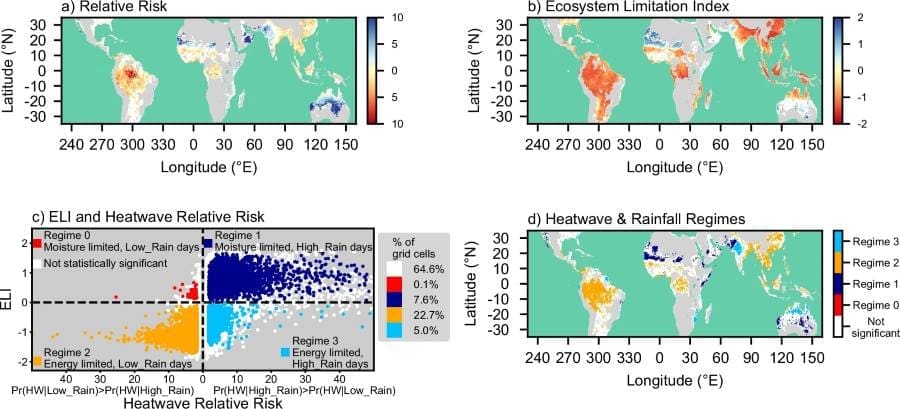Summary:
Humid heatwaves, which can overwhelm the body’s ability to regulate temperature and cause severe health risks, are becoming more frequent and intense in tropical and subtropical regions.
A new study led by researchers at the University of Leeds and the UK Centre for Ecology and Hydrology has revealed that recent rainfall patterns are a key factor in triggering these dangerous events. The research, published in Nature Communications, shows that the timing and nature of rainfall — whether it increases or decreases over several days — can set the stage for extreme humid heat depending on local soil moisture levels. In moisture-limited environments, where land is generally dry, enhanced rainfall can increase the likelihood of heatwaves during or just after the rain.
In contrast, in energy-limited environments, where land is already moist, heatwaves are more likely after two or more dry days. This discovery opens the door to improved early warning systems by linking satellite observations of rainfall and soil moisture to the risk of humid heat. According to the researchers, this understanding could help protect vulnerable communities, particularly in monsoon and humid coastal regions, where even small increases in global temperatures can drastically raise the danger posed by humid heat.

Rainfall triggers extreme humid heat in tropics and subtropics
The team, from the University of Leeds and the UK Centre for Ecology and Hydrology has provided the first ever analysis of how patterns of recent rainfall can interact with dry or moist land conditions to influence the risk of extreme humid heat in the global tropics and subtropics.
The study offers new insight which could lead to the development of early warning systems for vulnerable communities in those regions.
Climate change means humid heatwaves are a growing risk to human and animal health, especially in tropical regions. While there is established research into dry heatwaves, there is little understanding of the meteorological drivers of extreme humid heat.
Humid heat is related to heat stress, occurring when environmental conditions overwhelm the body’s ability to cool itself. Severe heat stress leads to an increase in the core body temperature of 3°C or more and can cause confusion, seizures, and loss of consciousness. If not treated promptly, severe heat stress can lead to muscle damage, major organ failure, and death.
Humid heatwaves are particularly concerning for humans because a wet-bulb temperature (a measure of temperature that accounts for how much cooling can occur through evaporation under ideal conditions) of 35°C means they are unable to shed heat effectively through sweating. Several subtropical coastal locations have already experienced this 35°C threshold.
Lead author of the study Dr Lawrence Jackson, a Research Fellow in the School of Earth and Environment, said: “With climate change driving more frequent and intense humid heat events, particularly in tropical and subtropical regions, the risks to vulnerable populations and outdoor workers are increasing.
“The new understanding provided by our research highlights the potential for improved humid heat early warning systems, using near real-time satellite observations for soil moisture and rainfall.”
The team studied humid heatwaves across the tropics and subtropics using weather and climate data from 2001 to 2022.
The researchers identified heatwave events and looked at how they were influenced by recent rainfall, using satellite observations to distinguish between wetter and drier days. They then calculated how likely a heatwave was to occur after these different rainfall conditions.
Humid heatwaves are widespread across the global tropics and subtropics. They occur in monsoon regions such as West Africa, India, East China, and north Australia, in humid regions such as the Amazon, southeast US, and the Congo basin, and in hot coastal regions in the Middle East.
The new study reveals that recent rainfall patterns play a critical role in triggering humid heatwaves in tropical and subtropical regions, with the results showing that the risk of humid heatwaves depends on whether the surface environment is drier or wetter.
In drier regions, humid heatwaves are more likely during or just after periods of enhanced rainfall. In wetter regions, humid heatwaves tend to follow at least two days of suppressed rainfall.
This difference arises because rainfall increases moisture in soils making conditions more humid. By contrast, less rainfall and fewer clouds allow the land to warm, thereby increasing temperatures.
Cathryn Birch, Professor in Meteorology and Climate in the School of Earth and Environment, led the study. She explained: “The outlook for tropical humid heat is really concerning. Humans avoid overheating by sweating. Evaporation of the sweat cools your body, allowing you to maintain a safe body temperature. Humidity makes this less effective.
“Humid heatwaves can be lethal at air temperatures that for dry heat would be relatively safe. The tropics are naturally humid and even an apparently small increase in global temperatures leads to large increases in dangerous humid heat extremes. We not only need to urgently cut greenhouse gas emissions but also need improved early warning systems for humid heat.”
Co-author John Marsham, a Professor of Atmospheric Science in the School of Earth and Environment, added: “Our results focus on the daily timescale for these heatwaves. An obvious next step would be to extend our analysis to hourly time scales which might allow us to work towards near real-time predictions with all the benefits that would bring to vulnerable communities.”
Journal Reference:
Jackson, L.S., Birch, C.E., Chagnaud, G. et al., ‘Daily rainfall variability controls humid heatwaves in the global tropics and subtropics’, Nature Communications 16, 3461 (2025). DOI: 10.1038/s41467-025-58694-6
Article Source:
Press Release/Material by University of Leeds
Featured image credit: Mabel | Pexels




